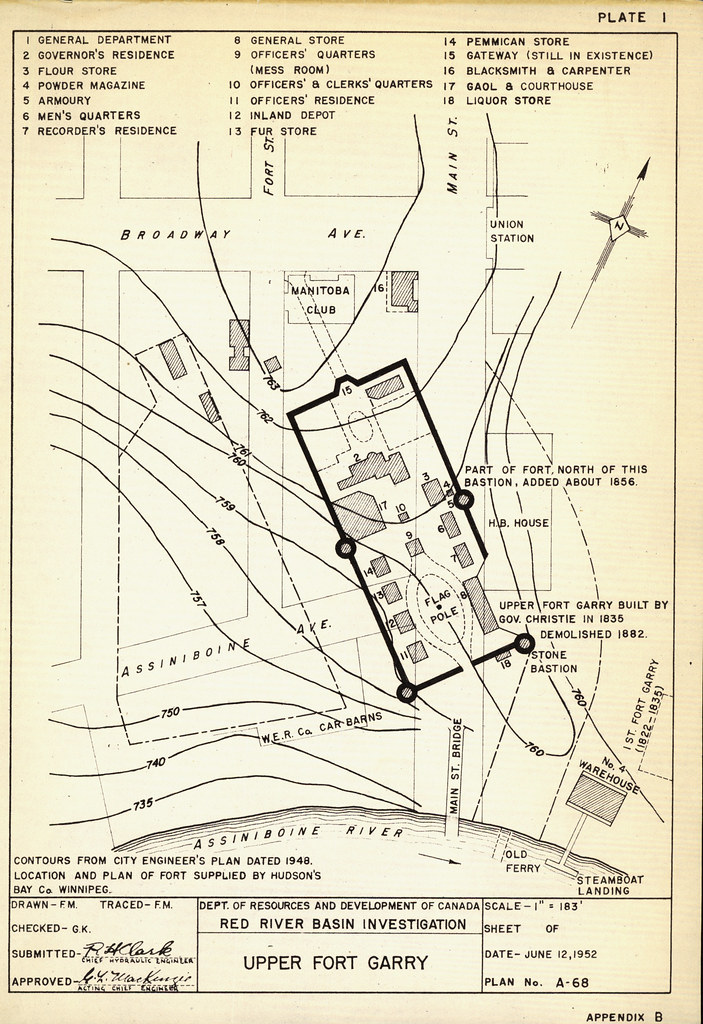Originally written April 13, 2008
I did some newspaper and Henderson Directory research on the gate. Here's what I found:
Late 1880s: The walls and gates were torn down to allow for the straightening of that section of Main street. One gate was saved, not a main gate but a private gate that allowed access to the house and gardens.
Image from Manitoba Historical Maps on Flickr
1897: “Gateway Park” around the remaining gate has been there in some form since the walls were removed. In 1897 “Gateway Park” was presented to the city by the HBC.

Image: Postcard of Gate with Manitoba Club in the background
1904: With a newly straightened and widened Main Street, the Winnipeg Electric Railway built their main car sheds at Assiniboine and Main. Aside from sheds, they would also build their rolling stock at this location (1904 – 1914) and generate electricity for the rail system.
from Winnipeg Colour Streetcar Photos
The layout for the west side of Main from the River to Broadway is as follows:
1905:
- Winnipeg Electric Railway Car Sheds
- 140 Hudson Bay Chambers
- 144 Wm Becher, Accountant
- 148 Alexander Burgess, Secretary
1911:
- Winnipeg Electric Railway Car Sheds- Fort Garry (Gateway) Park
- 140 – 148 Vacant
1916:
- Winnipeg Electric Railway Car Sheds
- Athletic Grounds (included a soccer pitch and some track and field)
- Fort Garry Park
1920:
- Winnipeg Electric Railway Car Sheds
- Athletic Grounds
- Fort Garry Park
1925:
- Winnipeg Electric Railway Car Sheds
- Fort Garry Stadium
- Athletic Grounds- Fort Garry Park
- 142 Fort Garry Gate Service Centre- The stadium was a small open air stadium with soccer and rugby in summer and ice skating in winter.
- The service station appears on the site (140 Main Street) was the Fort Garry Gate Service Station (Phone 23-777 !) in 1925. It was owned by Thomas E Montgomery of 5-559 Ellice and George Alvare of 703 Anderson.
1930’s: The city parks committee received more land around the site in the 30’s. The parks board, after years of creating large scale parks, now wanted to focus on small, corner lots and neighbourhood parks. The manager of the Bank of Montreal told the parks board that on a recent visit to England that he brought the matter of additional HBC land around the gate be given to the city with the HBC Governor.
1936: There was sentiment, even back then, for the gate. An op-ed in the May 21, 1936 FreeP by Archbishop Matheson said: “in view of…the important part which the fort played in the early history of what is now Manitoba does in not seem regrettable that in 1880 the old fort was demolished and nothing left except on of its gates ? …. Will the time come when we shall allow the old Fort Garry Gate to disappear ?”
1948: Grain Exchange Club/Rink is constructed at 75 Fort Street
1949: “City May Reconstruct Old Fort Garry Gate” story appears in the Freep. The gate was in disrepair and they was a study underway to find out the costs to reconstruct it.
1953: The Fort Garry Chamber of Commerce felt that the gate should be theirs, as it was not located in “Fort Garry”, and made a play for the gate. They offered the city $500 to purchase it and move it to the Chamber’s centre on Pembina Highway “to return it to its rightful home”. (FreeP April 13 1953).
1960: Metro Council agrees to purchase the Imperial Oil Building at 100 Main Street for $500k. At the time the council, was already leasing space for it's executive offices and planning department at this location. With the transit garage right next door it was thought that this would make a good location for a future city hall.
1963: Plans appear for the reconstruction of LOWER Fort Garry wich could become “Western Canada’s greatest tourist attraction” (FreeP June 22 1963). Perhaps spurred on by the talk of revitalizing Lower Fort Garry the city does a large cleanup around the gate. Trees that hid the site were removed and new landscaping and flower gardens were installed.
1972: The idea of expanding the park was touted as a good project for the 1974 Centennial Year Celebrations. On December 22 it was reported that an agreement was reached on a plan to expand the park site and rebuild a replica of one of the old fort buildings. It noted that “the expansion of the park, located behind the Manitoba Club, …was part of Metro’s original downtown development plan”.
The plan was to take over the gas station and Manitoba Club sites and possibly have the area declared a National Historic Site. In the end the Centennial library, instead, became the Centennial project for the city.
1975: The gas station, (a Gulf since 1973) applied to demolish the old fashioned service station and replace it with a self serve. Once again this got wheels turning at city hall - an article in the September 10, 1975 FreeP said that the city was looking to purchase the service station lot “for completion of the Fort Garry Gate Park area”. DI McDonald, Chief Commissioner, said the land was “one of the really significant historical sites in the city”
2008: After decades of relative inaction, the city put a tender out for the 100 Main stie and adjacenet parking lot. In the end, a group called Friends of Upper Fort Garry intervened to stop any development deal to allow time to fundraise and purchase the land to create a larger park and interpretive centre.



No comments:
Post a Comment